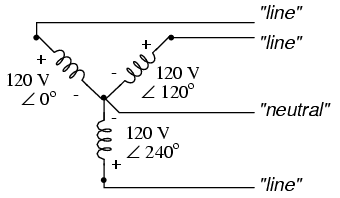Three-Phase Circuits =)
Initially we explored the
idea of three-phase power systems by connecting three voltage sources together
in what is commonly known as the “Y” (or “star”) configuration. This
configuration of voltage sources is characterized by a common connection point
joining one side of each source. (Figure below)

Three-phase “Y” connection
has three voltage sources connected to a common point.
If we draw a circuit showing
each voltage source to be a coil of wire (alternator or transformer winding)
and do some slight rearranging, the “Y” configuration becomes more obvious in
Figure below.

Three-phase, four-wire “Y”
connection uses a "common" fourth wire.
The three conductors leading
away from the voltage sources (winding's) toward a load are typically called
lines, while the windings themselves are typically called phases. In a
Y-connected system, there may or may not (Figure below) be a neutral wire
attached at the junction point in the middle, although it certainly helps
alleviate potential problems should one element of a three-phase load fail
open, as discussed earlier.

Three-phase, three-wire “Y”
connection does not use the neutral wire.
Overview and Insights
-The conductors connected to
the three points of a three-phase source or load are called lines.
-The three components
comprising a three-phase source or load are called phases.
-Line voltage is the voltage
measured between any two lines in a three-phase circuit.
-Phase voltage is the voltage
measured across a single component in a three-phase source or load.
-Line current is the current
through any one line between a three-phase source and load.
-Phase current is the current
through any one component comprising a three-phase source or load.
-In balanced “Y” circuits,
line voltage is equal to phase voltage times the square root of 3, while line
current is equal to phase current.

-In balanced Δ circuits, line
voltage is equal to phase voltage, while line current is equal to phase current
times the square root of 3.

-Δ-connected three-phase
voltage sources give greater reliability in the event of winding failure than
Y-connected sources. However, Y-connected sources can deliver the same amount
of power with less line current than Δ-connected sources.
Walang komento:
Mag-post ng isang Komento